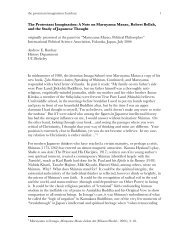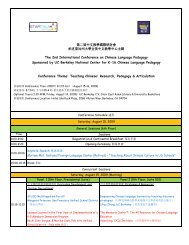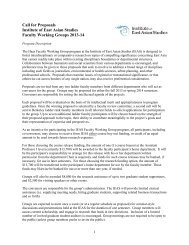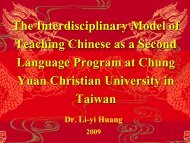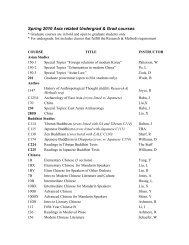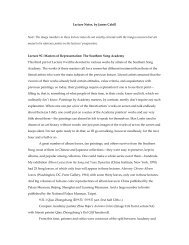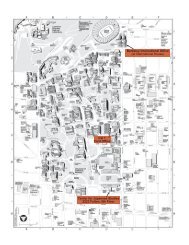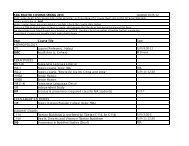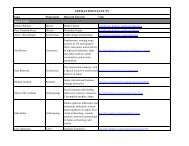Third Edition Spring 2013 - Institute of East Asian Studies, UC ...
Third Edition Spring 2013 - Institute of East Asian Studies, UC ...
Third Edition Spring 2013 - Institute of East Asian Studies, UC ...
You also want an ePaper? Increase the reach of your titles
YUMPU automatically turns print PDFs into web optimized ePapers that Google loves.
produce political resistance, social solidarity, and civic virtue. 7 InVietnam’s history there are many examples <strong>of</strong> each <strong>of</strong> these politicalevents as leaders have utilized a constructed identity to anchortheir legitimacy to power. With this being understood I draw attentionto the process by which a culture memory is produced.Production <strong>of</strong> Cultural MemoriesIn Destination Culture, Barbara Gimblett discusses how cultureis produced. Her focus is on heritage as the new mode <strong>of</strong> cultureproduction in the present and how it has recourse in the past.Gimblett emphasizes how:Heritage is not lost and found, stolen and reclaimed. Despite a discourse<strong>of</strong> conservation, preservation, restoration, reclamation, recovery,re-creation, recuperation, revitalization, and regeneration, heritageproduces something new in the present that has recourse to thepast. Such language suggests that heritage is there prior to its identification,evaluation, conservation, and celebration. By production, I donot mean that the result is not “authentic” or that it is wholly invented.Rather, I wish to underscore that heritage is not lost and found, stolenand reclaimed. It is a mode <strong>of</strong> cultural production in the present thathas recourse to the past.Gimblett’s analysis <strong>of</strong> culture production serves as a tool for understandingphotography in Vietnam.As Gimblett’s writings stress, culture is neither lost norfound. Culture is ubiquitous and takes on various forms. Vietnamis comprised <strong>of</strong> an ethnically diverse people, however the governmenthas promoted one cultural identity, namely the identity constructedby the Communist party. At no point in Vietnam’s historyhas a constructed culture been so clearly produced than <strong>of</strong> thatsurrounding the Vietnam War. This identity is remarkably visiblein the photography <strong>of</strong> the Vietnamese during this period, and iseven more identifiable when compared with that <strong>of</strong> the Americans.7 Tai, Hue-Tam Ho. The Country <strong>of</strong> Memory: Remaking the past in Late SocialistVietnam. Berkeley: University <strong>of</strong> California, 2001.Contrasting FocusesUnlike Westerners who were primarily in Vietnam on a “voluntarybasis and could walk away if they so desired, the freedom toleave their country and the war was not an option for Vietnamesephotographers.” 8 The war was at home for Vietnamese photographersand their contingence to the domestic suffering <strong>of</strong> war permeatedthe meanings and subjects that Vietnamese photographerschose to capture, as well as into the images that the National LiberationFront promoted. In addition, Vietnamese photojournalismwas not predicated on violence and disaster alone, but upon theplacement <strong>of</strong> suffering within a broader spectrum <strong>of</strong> wartime experiencesand subjectivities, and it thus produced a more extensiveand informative visual history. 9 As explained in Schwenkel’s writings,culture played a huge role in what was photographed by theVietnamese during the war.Unlike reporters working for the Western press, most <strong>of</strong> whomwere independent <strong>of</strong> the war effort and thus regarded as “objective”outside observers, Vietnamese correspondents were consideredcultural soldiers <strong>of</strong> the revolution, whose weapons consisted<strong>of</strong> pencils, paper, and in the case <strong>of</strong> photojournalists, cameras. Ininterviews and conversations, photographers stressed the importance<strong>of</strong> photography to serve the country, denounce the war tonational and international audiences, and transmit and propagateinformation from the front. But they also emphasized their multivalentroles as cultural producers immersed in the social worlds <strong>of</strong>the people who comprised their subject matter. They endeavoredto show the crimes, destruction, and techniques <strong>of</strong> war, as well asthe cooperation, compassion, and social interactions among soldiersand villagers.Despite the variety <strong>of</strong> cultural messages captured by Viet-8 Schwenkel, Christina. Exhibiting War, Reconciling Pasts: Photographic Representationand Transnational Commemoration in Contemporary Vietnam. Journal <strong>of</strong>Vietnamese <strong>Studies</strong> 3.1, 2008.9 Ibid29 Mark Portillo Constructing “Culture” 30




